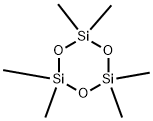Methyltris(trimethylsiloxy)silane
- CAS NO.:17928-28-8
- Empirical Formula: C10H30O3Si4
- Molecular Weight: 310.69
- MDL number: MFCD00040007
- EINECS: 241-867-7
- SAFETY DATA SHEET (SDS)
- Update Date: 2025-12-17 09:49:22

What is Methyltris(trimethylsiloxy)silane ?
The Uses of Methyltris(trimethylsiloxy)silane
Methyltris(trimethylsiloxy)silane was used in the study of thermal rearrangement of branched-chain methylpolysiloxanes.
Definition
ChEBI: Methyltris(trimethylsiloxy)silane is an organosilicon compound.
General Description
Clear colorless liquid.
Air & Water Reactions
Insoluble in water.
Fire Hazard
Methyltris(trimethylsiloxy)silane is combustible.
Flammability and Explosibility
Flammable
Properties of Methyltris(trimethylsiloxy)silane
| Melting point: | -76°C |
| Boiling point: | 60 °C |
| Density | 0.849 |
| vapor pressure | 2.1hPa at 25℃ |
| refractive index | 1.3880 |
| Flash point: | 61°C |
| form | liquid |
| color | Colorless to Almost colorless |
| Specific Gravity | 0.849 |
| Water Solubility | <0.1 g/100 mL at 20 ºC |
| Hydrolytic Sensitivity | 1: no significant reaction with aqueous systems |
| CAS DataBase Reference | 17928-28-8(CAS DataBase Reference) |
| NIST Chemistry Reference | Trisiloxane, 1,1,1,3,5,5,5-heptamethyl-3-(trimethylsiloxy)-(17928-28-8) |
| EPA Substance Registry System | Trisiloxane, 1,1,1,3,5,5,5-heptamethyl-3-[(trimethylsilyl)oxy]- (17928-28-8) |
Safety information for Methyltris(trimethylsiloxy)silane
| Signal word | Warning |
| Pictogram(s) |
 Exclamation Mark Irritant GHS07 |
| GHS Hazard Statements |
H227:Flammable liquids H315:Skin corrosion/irritation H319:Serious eye damage/eye irritation |
| Precautionary Statement Codes |
P210:Keep away from heat/sparks/open flames/hot surfaces. — No smoking. P264:Wash hands thoroughly after handling. P264:Wash skin thouroughly after handling. P280:Wear protective gloves/protective clothing/eye protection/face protection. P302+P352:IF ON SKIN: wash with plenty of soap and water. P305+P351+P338:IF IN EYES: Rinse cautiously with water for several minutes. Remove contact lenses, if present and easy to do. Continuerinsing. P332+P313:IF SKIN irritation occurs: Get medical advice/attention. P337+P313:IF eye irritation persists: Get medical advice/attention. P370+P378:In case of fire: Use … for extinction. P403+P235:Store in a well-ventilated place. Keep cool. |
Computed Descriptors for Methyltris(trimethylsiloxy)silane
New Products
4,4-Difluoropiperidine hydrochloride tert-butyl 9-methoxy-3-azaspiro[5.5]undecane-3-carboxylate Indole Methyl Resin N-Isopropylurea N,N-Dicyclohexylcarbodiimide(DCC) MELDRUMS ACID 5-METHYLISOXAZOLE-4-CARBOXYLIC ACID Magnessium Bis glycinate Zinc ascorbate 1-bromo-2-butyne 2-acetamidophenol 9(10H)-anthracenone Erythrosin B, 4-Piperidinopiperidine 2-((4-morpholinophenylamino) (methylthio) methylene) malononitrile 2,4-dihydroxybenzaldehyde 3-(4-morpholinophenylamino)-5-amino-1H-pyrazole-4-carbonitrile Methyl 2-methylquinoline-6-carboxylate 2,6-dichloro-4-nitropyridine 4-Bromo-2-chlorobenzonitrile 2-(benzylamino)acetic acid hydrochloride 4-(tert-Butoxycarbonylamino)but- 2-ynoic acid 3,4-dihydro-2H-benzo[b][1,4]dioxepine 1-Phenyl-1-cycloprppanecarboxylicacidRelated products of tetrahydrofuran








You may like
-
![1,1,1,3,5,5,5-Heptamethyl-3-[(trimethylsilyl)oxy]trisiloxane CAS 17928-28-8](https://img.chemicalbook.in//Content/image/CP5.jpg) 1,1,1,3,5,5,5-Heptamethyl-3-[(trimethylsilyl)oxy]trisiloxane CAS 17928-28-8View Details
1,1,1,3,5,5,5-Heptamethyl-3-[(trimethylsilyl)oxy]trisiloxane CAS 17928-28-8View Details
17928-28-8 -
 3-(4-amino-1-oxoisoindolin-2-yl)-1-methylpiperidine-2,6-dione 98%View Details
3-(4-amino-1-oxoisoindolin-2-yl)-1-methylpiperidine-2,6-dione 98%View Details -
 614-19-7 98%View Details
614-19-7 98%View Details
614-19-7 -
 3112-85-4 Methyl phenyl sulfone 98%View Details
3112-85-4 Methyl phenyl sulfone 98%View Details
3112-85-4 -
 20677-73-0 (2,2-diethoxyethyl)methylamine 98%View Details
20677-73-0 (2,2-diethoxyethyl)methylamine 98%View Details
20677-73-0 -
 3-(4-(hydroxyamino)-1-oxoisoindolin-2-yl)piperidine-2,6-dione 98%View Details
3-(4-(hydroxyamino)-1-oxoisoindolin-2-yl)piperidine-2,6-dione 98%View Details -
 57381-49-4 2-bromo-4-chlorobenzonitrile 98%View Details
57381-49-4 2-bromo-4-chlorobenzonitrile 98%View Details
57381-49-4 -
 4,6-dichloropyrimidine-5-carbaldehyde 98%View Details
4,6-dichloropyrimidine-5-carbaldehyde 98%View Details
5305-40-8
Statement: All products displayed on this website are only used for non medical purposes such as industrial applications or scientific research, and cannot be used for clinical diagnosis or treatment of humans or animals. They are not medicinal or edible.
